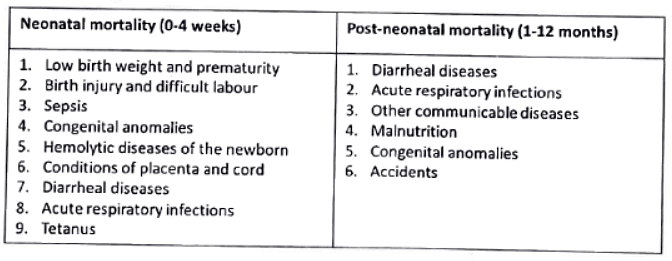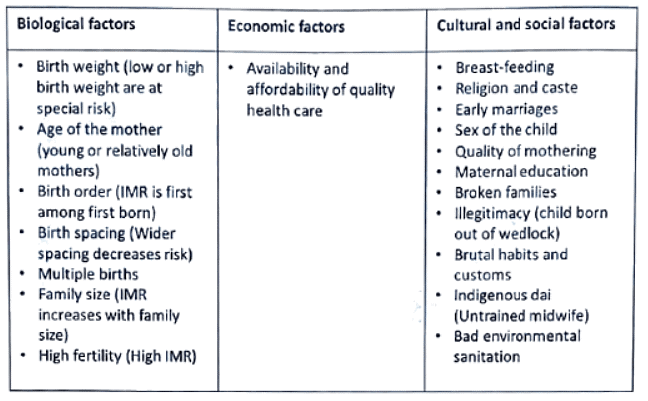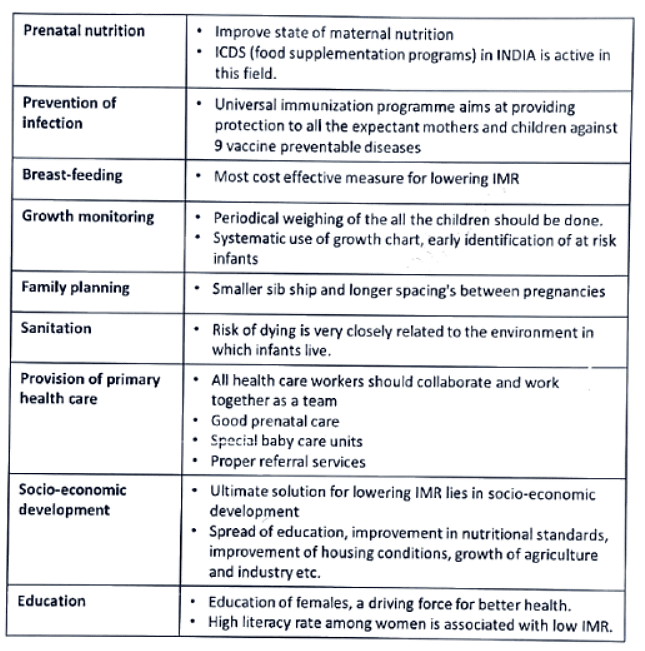UPSC Exam > UPSC Notes > Medical Science Optional Notes for UPSC > Infant Mortality Rate
Infant Mortality Rate | Medical Science Optional Notes for UPSC PDF Download
Infant Mortality Rate Definition
- IMR is defined as ratio of infant deaths registered in a given year to the total number of live births registered in the same year: usually expressed as a rate per 1000 live births.
- IMR = Number of deaths if children less than 1 year of age in a year/ (divided by) number of live births in the same year XD (multiplied by) 1000
Why IMR is given a special treatment by demographers?
- It is the largest single age-category of mortality
- Deaths at this age are due to peculiar set of diseases and conditions to which adult population is less exposed or less vulnerable
- It is effected rather quickly and directly by specific health programmes and hence may change more rapidly than the general death rate.
- They reflect socio-economic development of a country
- IMR of India in the year 1990 is 88 and in the year 2017 it is 32.
Question for Infant Mortality RateTry yourself: What does the Infant Mortality Rate (IMR) represent?View Solution
The decline in IMR is attributed to
- Improved obstetric and perinatal care, e.g., availability of foetal monitoring during labour, improved techniques for the induction of labour
- Improvement in the quality of life, that is, economic and social progress
- Better control of communicable diseases, e.g., immunization and oral rehydration
- Advances in chemotherapy, antibiotics and insecticides
- Better nutrition, e.g., emphasis on breast feeding
- Family planning, e.g., birth spacing.
Causes
Causes of IMR are multifactorial
Factors effecting IMR

Preventive and social measures

Infant Mortality Rate-Repeat
Q: Define "Infant Mortality Rate". List the major causes of IMR in India. What are the key steps that can bring down the IMR in lndia? (2015)
The document Infant Mortality Rate | Medical Science Optional Notes for UPSC is a part of the UPSC Course Medical Science Optional Notes for UPSC.
All you need of UPSC at this link: UPSC
|
7 videos|236 docs
|
FAQs on Infant Mortality Rate - Medical Science Optional Notes for UPSC
| 1. What is the definition of Infant Mortality Rate (IMR)? |  |
Ans. Infant Mortality Rate (IMR) is a measure used by demographers to calculate the number of deaths of infants (those under the age of one) per 1,000 live births in a given population during a specific time period, usually a year.
| 2. Why is IMR given special treatment by demographers? |  |
Ans. IMR is given special treatment by demographers because it is considered a crucial indicator of the overall health and well-being of a population. It reflects the quality of healthcare services, access to clean water and sanitation facilities, and socio-economic conditions. High IMR rates are often associated with poor healthcare infrastructure and lower socio-economic development.
| 3. How is IMR calculated? |  |
Ans. IMR is calculated by dividing the number of infant deaths in a given period by the number of live births during the same period, and then multiplying the result by 1,000. The formula for calculating IMR is:
IMR = (Number of Infant Deaths / Number of Live Births) x 1,000
| 4. What is the significance of IMR in public health policies? |  |
Ans. IMR plays a critical role in public health policies as it helps identify areas of concern and assess the effectiveness of healthcare programs and interventions. By monitoring IMR trends over time, policymakers can make informed decisions to improve maternal and child health services, allocate resources appropriately, and address the underlying causes of infant mortality.
| 5. How does IMR impact a country's development? |  |
Ans. IMR is considered a vital indicator of the socio-economic development of a country. Low IMR rates are often associated with better healthcare systems, higher literacy rates, and improved socio-economic conditions. Reducing IMR is a key goal for governments worldwide as it not only signifies improved health outcomes but also contributes to human capital development, economic growth, and overall social progress.
Related Searches















